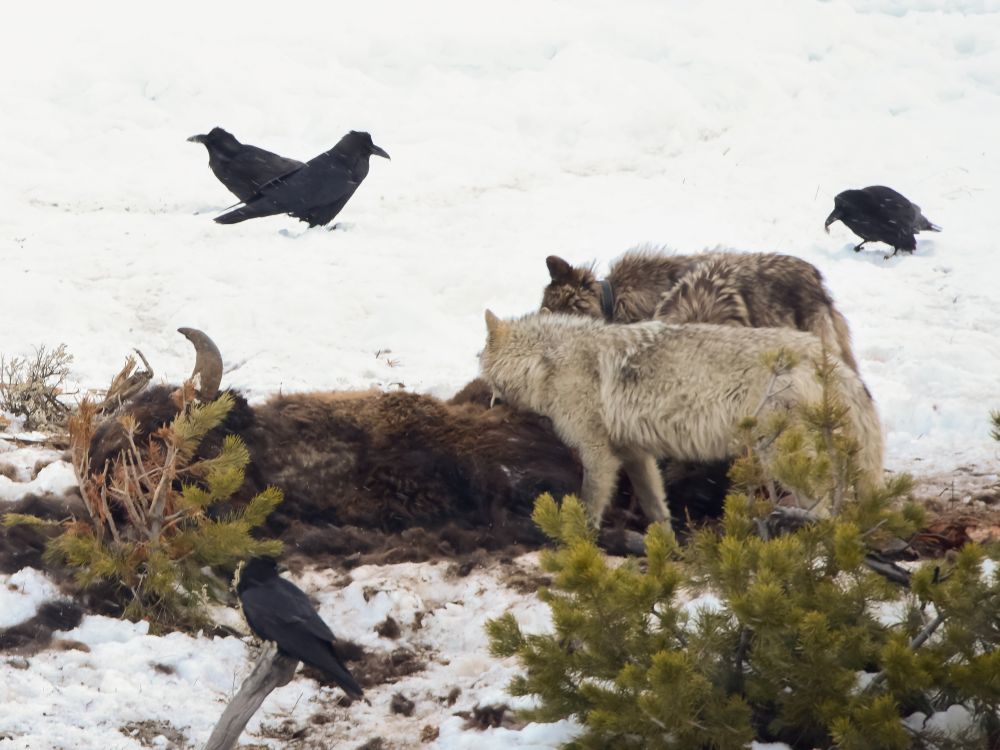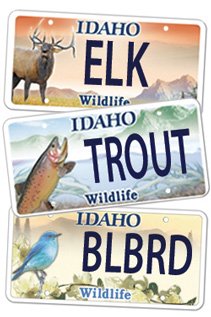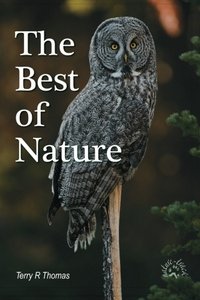Ravens and Wolves

Wolves and common ravens do more than tolerate each other. Theirs is a mutualistic relationship where both species benefit.
The Norse god Odin was known as the Raven God. On his shoulders sat Huggin (Thought) and Muggin (Wisdom). Each day his ravens would fly down to the world of mortals to serve as Odin's eyes and ears. Returning to Asgard, they would rest upon Odin's shoulders and whisper all the secrets of the world into his ears.
Several years ago, we spent several hours watching the relationships between a pack of wolves, numerous common ravens, a coyote, and a red fox as they all shared the carcass of a bison killed by the wolves. I thought about Odin and his ravens and the unique relationship that ravens have with wolves (another species associated with Odin).
It is pretty easy to assume that the ravens are just bystanders to the killing of a prey animal by wolves, ready to swoop in and scavenge as much meat as the wolves would tolerate. However, researchers at Isle Royale National Park, an Island in Lake Superior, have been conducting research on wolf/moose interactions for over 60 years and they came up with a different theory.
For a long time, researchers could not understand the wolf strategy of using larger packs to hunt. Certainly, pulling down prey was easier with large packs, but then the prize had to be shared with many mouths. Calculations repeatedly demonstrated that if wolves hunted in pairs rather than a pack, they would get more of the meat for each individual wolf. Why then, didn’t they hunt in pairs?
Enter the common raven. In Yellowstone National Park, these birds are present at over 99 percent of all wolf kills. While a wolf can eat up to 13 pounds of meat in a meal, a two-pound raven can eat or stash up to four pounds. With an average flock of ravens at a carcass, they can account for 40 percent of the meat consumed from a carcass. With the scavenging calculated into the equation, it turned out that a wolf pack would get more meat from a kill than a pair of wolves, largely due to the raven.
Why then would the wolves tolerate the ravens at the kill if they are going to lose so much protein? It appears that there is a complex social interaction occurring between the two species. For instance, there are documented occurrences of ravens playing tug-of-war with young wolf pups and even flying above them with a stick and teasing them into trying to grab the stick. That wolves and ravens have a unique bond becomes clearer.
However, here is where the story of Odin’s ravens plays a role. Just as Huggin and Muggin would return and report to Odin about all the activities of humans on Earth, common ravens may serve as the eyes and the ears of the wolf pack. Ravens are just as dependent upon meat to survive the winter as wolves are, but they are unable to hunt large animals. In a mutualistic relationship with wolves though, the ravens patrol the skies. When they encounter an injured animal, they make it known with loud squawking, which in turn attracts the wolves. The wolves make the kill and the ravens get some of the meat as a reward.
Wolves and ravens are both highly intelligent animals. It should come as no surprise that somewhere along the way they learned that working together was far more beneficial than always being at odds. We are still waiting for humans to learn that same lesson.
Help Idaho Wildlife
When we traveled across the state in October 2017, we visited most of the Idaho Department of Fish and Game wildlife management areas. Most of the vehicles we saw using the wildlife management areas did not have wildlife plates. Buying wildlife plates is a great way for non-hunters and hunters alike to support wildlife-based recreation like birding.
C'mon folks, let's help Idaho's wildlife by proudly buying and displaying a wildlife license plate on each of our vehicles!
See below for information on Idaho plates. Most states have wildlife plates so if you live outside Idaho, check with your state's wildlife department or vehicle licensing division for availability of state wildlife plates where you live.
And tell them that you heard about it from Nature-track.com!

Wildlife License Plates
Great news! as of 2024, there are three NEW designs for license plates. They still are bluebird, cutthroat trout and elk, but they are beautiful.
Idaho Wildlife license plates provide essential funding that benefits the great diversity of native plants and wildlife that are not hunted, fished or trapped—over 10,000 species or 98% of Idaho’s species diversity. Game species that share the same habitats (such as elk, deer, antelope, sage-grouse, salmon, trout) also benefit from these specialty plates.
No state tax dollars are provided for wildlife diversity, conservation education and recreation programs. Neither are any revenues from the sale of hunting or fishing licenses spent on nongame species. Instead, these species depend on direct donations, federal grants, fundraising initiatives—and the Idaho Wildlife license plates.
Both my vehicles have Bluebird Plates. I prefer the bluebird because the nongame program gets 70 percent of the money from bluebird plates, but only 60 percent of the money from elk and trout plates - 10 percent of the money from elk plates supports wildlife disease monitoring and testing programs (to benefit the livestock industry) and 10 percent from cutthroat plates supports non-motorized boat access.
Incidentally, in 2014, the Idaho Legislature denied the Department of Fish and Game the ability to add new plates or even to change the name of the elk and cutthroat plates (very specific) to wildlife and fish plates, a move that would have allowed for changing images occasionally and generating more revenue. It would seem that they believe that we Idahoans don't want a well funded wildlife program.
I think it is time we let the Legislature know that Idahoan support wildlife funding and that we would like to see these generic plates come to fruition.

"WOW. What a phenomenal piece you wrote. You are amazing." Jennifer Jackson
That is embarrassing, but actually a fairly typical response to my nature essays. Since The Best of Nature is created from the very best of 16 years of these nature essays published weekly in the Idaho Falls Post Register (online readership 70,000), it is a fine read. It covers a wide variety of topics including humorous glimpses of nature, philosophy, natural history, and conservation. Readers praise the style, breadth of subject matter and my ability to communicate complex and emotional topics in a relaxed and understandable manner.
Everyone can find something to love in this book. From teenagers to octogenarians, from the coffee shop to the school room, these nature essays are widely read and enjoyed.
Some of the essays here are my personal favorites, others seemed to strike a chord with readers. Most have an important message or lesson that will resonate with you. They are written with a goal to simultaneously entertain and educate about the wonderful workings of nature. Some will make you laugh out loud and others will bring a tear to the eye and warm your heart.
Readers Write:
"You hit a home run with your article on, Big Questions in Nature. It should be required reading for everyone who has lost touch with nature...great job!" Joe Chapman
"We enjoyed your column, Bloom Where Planted. Some of the best writing yet. The Post Register is fortunate to have your weekly columns." Lou Griffin.
To read more and to order a copy, click here or get the Kindle version
Copies are also available at:
Post Register
Island Park Builders Supply (upstairs)
Barnes and Noble in Idaho Falls
Harriman State Park, Island Park
Museum of Idaho
Valley Books, Jackson Wyoming
Avocet Corner Bookstore, Bear River National Wildlife Refuge, Brigham City, Utah
Craters of the Moon National Monument Bookstore, Arco, Idaho